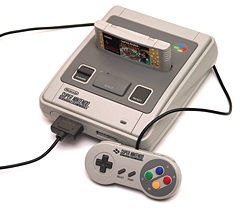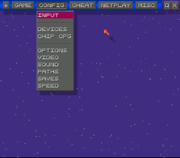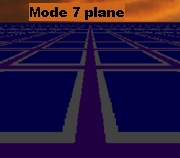
SNES Console Information

SNES console

SNES logo
- Manufacturer: Nintendo
- Type: Video game console
- Generation: Fourth generation (16-bit era)
- First available: Japan: November 21, 1990
- North America: August 13, 1991
- Europe: April 11, 1992
- Australia: July 3, 1992
- Online service: Satellaview (Japan Only), XBAND
- Units sold: 49 million
- Top selling game: Super Mario World
- Predecessor: Nintendo Entertainment System
- Successor: Nintendo 64
Details
The Super Nintendo Entertainment System or Super NES (also called SNES and Super Nintendo) was a 16-bit video game console released by Nintendo in North America, Europe, Australasia, and Brazil between 1990 and 1993. In Japan and Southeast Asia, the system is called the Super Family Computer, Super Famicom , or SFC for short. In South Korea, it is known as the Super Comboy and was distributed by Hyundai Electronics. Although each version is essentially the same, several forms of regional lockout prevent direct compatibility. The Super Nintendo Entertainment System was Nintendo's second home console, following the Nintendo Entertainment System (NES). The console introduced advanced graphics and sound capabilities that compensated for its relatively slow CPU, compared with other consoles at the time. Additionally, the system's support for numerous enhancement chips (which shipped as part of certain game cartridges) helped to keep it competitive in the marketplace. The SNES was a global success, becoming the best-selling console of the 16-bit era despite its relatively late start and the fierce competition it faced in North America from Sega's Genesis console. The SNES remained popular well into the 32-bit era, and although Nintendo has dropped all support for the console, it continues to be popular among fans, collectors, and emulation enthusiasts, some of whom are still making "homebrew" ROM images.
History
To compete with the popular NES/Famicom, NEC launched the Turbografx-16/PC-Engine in 1987, and Sega followed suit with the Genesis/Mega Drive in 1988. Both systems were built on 16-bit architectures and offered improved graphics and sound over the 8-bit NES. However, the NES would continue to dominate the gaming market for several years before Sega's system finally became successful. Nintendo executives were initially reluctant to design a new system, but they reconsidered when the NES hardware began to show its age. Seeing its dominance in the market slipping, Nintendo was compelled to create a new console to compete with its 16-bit rivals.
Launch
Designed by Masayuki Uemura, the designer of the original Famicom, the Super Famicom was released in Japan on November 21, 1990 for ¥25,000 (US$210). It was an instant success: Nintendo's initial shipment of 300,000 units sold out within hours, and the resulting social disturbance led the Japanese government to ask video game manufacturers to schedule future console releases on weekends. The system's release also gained the attention of the Yakuza, leading to a decision to ship the devices at night to avoid robbery.
Console Wars
The rivalry between Nintendo and Sega resulted in a fierce console war in which Sega positioned the Genesis as the "cool" console, with edgy advertisements occasionally attacking the competition and more mature titles aimed at older gamers. Despite the Genesis's head start, its much larger library of games and its lower price point, market share between the SNES and the Genesis was about even in April 1992, and neither console could maintain a definitive lead for several years. The Super NES eventually prevailed, dominating the American 16-bit console market, and would even remain popular well into the 32-bit generation.
Changes in Policy
During the NES era, Nintendo maintained exclusive control over titles released for the system—the company had to approve every game, each third-party developer could only release up to five games per year, those games could not be released on another console within two years, and Nintendo was the exclusive manufacturer and supplier of NES cartridges. However, competition from Sega's console brought an end to this practice; in 1990, Acclaim began releasing games for both platforms, with most of Nintendo's other licensees following suit over the next several years; Capcom (which licensed some games to Sega instead of producing them directly) and Square were the most notable holdouts.
The 32-bit era and beyond
Nintendo of America ceased production of the SNES in 1999, about a year after releasing Kirby's Dream Land 3 (its last first-party game for the system) on November 27, 1997. The last SNES title to be released in the U.S. was a version of Frogger in 1998. In Japan, Nintendo continued production of the Super Famicom until September 2003, and new games were produced until the year 2000, ending with the release of Metal Slader Glory Director's Cut on December 1, 2000. Some consider the SNES to embody the "Golden Age of video games", citing its many groundbreaking games and the perceived focus on gameplay over graphics and technical gimmicks. Others question this perceived romanticism, believing the system was just another step in the evolution of video game technology.
Emulation
 Emulation projects began with the initial release of VSMC in 1994, and Super
Pasofami became the first working SNES emulator in 1996. During that time,
two competing emulation projects—Snes96 and Snes97—merged to form a new initiative
entitled Snes9x. In 1997, SNES enthusiasts began programming an emulator named
ZSNES. These two have remained among the best-known SNES emulators, although
development continues on others as well. Recently there has been a push for
exact emulation, begun in 2003 by members of both the Snes9x and ZSNES teams and
others, and currently led by the development of bsnes.
Emulation projects began with the initial release of VSMC in 1994, and Super
Pasofami became the first working SNES emulator in 1996. During that time,
two competing emulation projects—Snes96 and Snes97—merged to form a new initiative
entitled Snes9x. In 1997, SNES enthusiasts began programming an emulator named
ZSNES. These two have remained among the best-known SNES emulators, although
development continues on others as well. Recently there has been a push for
exact emulation, begun in 2003 by members of both the Snes9x and ZSNES teams and
others, and currently led by the development of bsnes.
Thecnical Specifications
The design of the Super NES incorporates a relatively slow CPU (half the speed of the Mega Drive), but the powerful graphics and sound co-processors allowed impressive tiling and Mode 7 effects, many times more colors, and audio quality that represented a massive leap over the competition. Individual game cartridges can easily supply further custom chips as needed.
Video
The picture processing unit (PPU) consists of two separate but closely tied IC packages, which may be considered as a single entity. It also contains 64 KB (KiB) of SRAM for storing video data (VRAM), 544 bytes of object attribute memory (OAM) for storing sprite data, and 512 bytes of color generator RAM (CGRAM) for storing palette data. The PPU is clocked by the same signal as the CPU, and generates a pixel every two or four cycles. Both NTSC and PAL systems use the same PPU chips, with one pin per chip selecting NTSC or PAL operation.
- Mode 7: 1 layer of 128x128 tiles from a set of 256, which may be interpreted as a 256-color one-plane layer or a 128-color two-plane layer. The layer may be rotated and scaled using matrix transformations. HDMA is often used to change the matrix parameters for each scanline to generate perspective effects.
Audio
The audio subsystem consists of an 8-bit Sony SPC700, a 16-bit DSP, 64 KB (KiB) of SRAM shared by the two chips, and a 64 byte boot ROM. The audio subsystem is almost completely independent from the rest of the system: it is clocked at a nominal 24.576 MHz in both NTSC and PAL systems, and can only communicate with the CPU via 4 registers on Bus B.
Onboard RAM
The console contains 128 KB (KiB) of DRAM. This is mapped to various segments of Bus A, and can also be accessed in a serial fashion via registers on Bus B. The video and audio subsystems contain additional RAM reserved for use by those processors.
Region Lockout

Cartridge shape comparison
Top: the Japanese version of the SNES cartridge
Bottom: The American version of the SNES cartridge
On a physical level, the cartridges are shaped differently for different regions. North American cartridges have a rectangular bottom with inset grooves matching protruding tabs in the console, while other regions' cartridges are narrower with a smooth curve on the front and no grooves. The physical incompatibility can be overcome with use of various adapters, or through modification of the console.
Console Casing
All versions of the SNES are predominantly gray, although the exact shade may differ. The original North American version has a boxy design with purple sliding switches and a dark gray eject lever. The Japanese and European versions are more rounded, with darker gray accents and buttons. The North American SNES 2 and the Japanese Super Famicom Jr. are both smaller with a rounded contour, however the SNES 2 buttons are purple where the Super Famicom Jr. buttons are gray.
Game cartridge
While the SNES can address 128 Mb (Mib), only 117.75 Mb are actually available for cartridge use. A fairly normal mapping could easily address up to 95 Mb of ROM data (48 Mb at FastROM speed) with 8 Mb of battery-backed RAM. However, most available memory access controllers only support mappings of up to 32 Mb. The largest games released (Star Ocean and Tales of Phantasia) contain 48 Mb of ROM data, while smallest games contain only 2 Mb. Cartridges may also contain battery-backed SRAM to save the game state, extra working RAM, custom coprocessors, or any other hardware that will not exceed the maximum current rating of the console.
Peripherals

European and PAL SNES controllers
The SNES standard controller adds two additional face buttons to the design of the NES iteration, arranging the four in a diamond shape, and the layout adds two shoulder buttons. It also features an ergonomic design later used for the NES 2. The Japanese and PAL region versions incorporate the system's logo in the colors of the four action buttons, while the North American version colors them lavender and purple to match the redesigned console. Many believe that several later consoles derive their controller design from the SNES, including the PlayStation, PS2, PS3, Dreamcast, Xbox, Xbox 360, and Wii (Classic Controller).
Enhancement Chips
As part of the overall plan for the SNES, rather than include an expensive CPU that would still become obsolete in a few years, the hardware designers made it easy to interface special coprocessor chips to the console. This is most often characterized by 16 additional pins on the cartridge card edge.